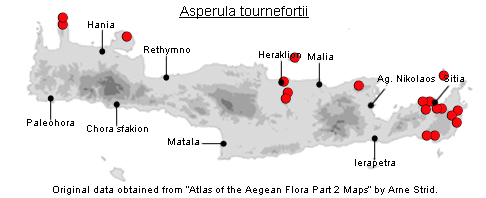ASPERULA TOURNEFORTII
Family:- RUBIACEAE/Sect. THLIPHTHISA
Common Names:- None
Synonyms:- Asperula majorii
Meaning:- Asperula (L) Little-rough-one.
Tournefortii (L) For Joseph Pitton de Toumefort (1656-1708),
renaissance plant systematist.
General description:- Covered with a "bloom" - with a waxy powdery secretion on
the surface (glaucous-pruinose).
Stems:- (10-)14-30(-35) cm, rigid, stout, more or less woody.
Leaves:- 12-15 x 6-10 mm, in whorls of 6(-7), broadly obovate, obtuse, thick,
leathery (coriaceous); vein scarcely prominent; margin weakly rolled toward lower
side.
Flowers:- Inflorescence pyramidal, rather dense, many-flowered, the flowers almost
stalkless; bracts about as long as the fruits, lance-shaped, hairy, not united at the
base. Corolla 3-5 mm, funnel-shaped, pale yellow, mostly long-hairy; tube c. 3·5
mm; lobes c. 0·7-1·5 mm, triangular. Style about as long as the ovary; stigma
shortly club-shaped.
Fruit:- 1·5-2 mm, Somewhat or minutely hairy.
Key features:-
1) Shrub or dwarf shrub, with persistent, linear-lanceolate or wider leaves.
2) Internodes as long as or shorter than leaves.
3) Leaves glaucous, obovate.
Habitat:- Crevices of limestone cliffs, often in gorges, with Centaurea argentea,
Helichrysum orientale, etc. 0-800 m. Fl. Late Apr to early July.
Distribution:- Endemic Crete, Saria, Kyklades, Halki & Rhodes. Grows in central and
eastern Crete except for a single population in the Akrofaringo gorge at the northern
end of the Rodopou peninsula.
Flowering time:- Late Apr to early July.
Photos by:- Steve Lenton
FAMILY AND GENUS DESCRIPTIONS
RUBIACEAE
General description:- Predominantly woody tropical family represented in Europe,
by more or less herbaceous plants with leaf-like stipules.
Leaves:- Nearly always opposite, simple, entire; stipules separate, joined margin
to margin (connate) or divided, sometimes leaf-like and then forming whorls of 4-12
apparent leaves.
Flower:- Radially symmetrical (actinomorphic), usually hermaphrodite.
Inflorescence a compact panicle of ± cylindrical form (thyrsoid), or with the lower
branches longer than the upper so that all end up at the same level (corymbose),
sometimes condensed to a spike or head, or reduced. Sepals usually free,
sometimes reduced or absent. Petals united (sympetalous); corolla with slender
tube and abruptly widening limb (hypocrateriform), funnel-shaped (infundibuliform),
cup-shaped or rotate. Stamens united with the petals (epipetalous), alternating with
the lobes of the corolla. Ovary inferior, usually with 2 compartments (2-locular) and
with a disc; loculi with 1-numerous ovules. Style simple or divided at the tip in two
(usually equal) parts by a median cleft (2-fid).
Fruit:- Dry, splitting away at maturity as a perfect fruit (mericarp), or fleshy. Seeds,
the nutritive tissue is absorbed more slowly into the developing embryo so that part
of it remains at least until germination (endospermic).
ASPERULA
General description:- Dwarf shrubs, perennial herbs or annuals.
Stems:- More or less distinctly 4-angled and not retrorsely aculeolate.
Leaves:- In whorls of 4-8(-11) or in pairs.
Flowers:- Inflorescence of panicles or capitula; ultimate branches with bracts and
often bracteoles. Flowers hermaphrodite, (3-)4(-5)-merous. Calyx absent or
consisting of short teeth. Corolla usually hypocrateriform to infundibuliform, rarely
rotate. Stigmas capitate or clavate. Ovary and fruit oblong to globose, never with
hooked hairs;
Fruit:- Dry.
Key features:-
1) Calyx absent.
2) Flowers in cymes or panicles.
3) Leaves in whorls of more than 4.
4) Pedicels with bracteoles; ovary and fruit oblong, truncate at apex.
5) Flowers not enclosed in membranous bracts; annual or perennial.
9) Ultimate inflorescence branches with bracts and often bracteoles.
Sect. THLIPHTHISA
General description:- Dwarf shrubs or perennial herbs, with woody taproot,
without rhizomes or stolons.
Leaves:- In whorls of 6-8(-11), elliptical to linear, 1-veined, obtuse to acuminate at
apex.
Flowers:- Inflorescence pyramidal to ovoid, leafy more or less throughout; partial
inflorescences with bracts and bracteoles. Corolla 4-merous, infundibuliform to
rotate, purplish, reddish, brownish, greenish, yellowish or whitish, externally smooth
and glabrous or hairy. Ovary and fruit oblong, truncate at apex, glabrous and more
or less granulate, rarely hairy.
Status:-
Conservation status (for threatened species): Rare (R) according to IUCN 1997.
Protection status (for threatened species): Greek Presidential Decree 67/1981.
SPECIES DESCRIPTION
